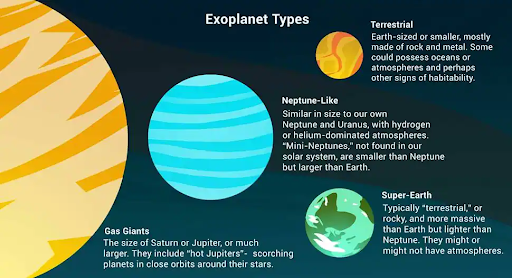Important Facts For Prelims
Hycean Worlds: Exoplanets
- 06 Sep 2021
- 3 min read
Why in News
Recently, some astronomers have identified a new class of exoplanets – Hycean worlds.
Key Points
- About:
- The word Hycean comes from the words hydrogen and ocean. Planet-wide oceans and hydrogen-rich atmospheres might cover these worlds.
- They are also uniquely alien, up to 2.6 times the diameter of Earth, with temperatures up to 200 degrees celsius and thick hydrogen atmospheres. This places them somewhere between Earth and giant planets like Neptune or Uranus.
- With no analogs in the Solar System, these planets are variedly classed as super-Earths or mini-Neptunes depending on inferences about their bulk compositions based on their densities.
- These planets, unlike most mini-Neptunes, may have solid surfaces, like Earth. Many of the known Hycean candidates are larger and hotter than Earth, but still would be able to host large oceans.
- Some Hyceans orbit so close to their stars that they're tidally locked, with one hot dayside and one eternally dark nightside. And some orbit very far away, receiving very little stellar radiation. But life could exist even on such extreme Hyceans.
- Tidal locking is the name given to the situation when an object’s orbital period matches its rotational period.
- Significance:
- The conditions on such planets might be similar to some of the more extreme aquatic environments on our planet, but could theoretically still support at least microbial life.
- Hycean worlds could greatly accelerate the search for life elsewhere. In some ways they are reminiscent of Earth, largely or even completely covered by oceans.
- Hycean worlds could support life different from that on Earth.
- Exoplanets:
- An exoplanet or extrasolar planet is a planet outside the Solar System. The first confirmation of detection of exoplanets occurred in 1992.
- More than 4,400 exoplanets have been discovered till now.
- They are very hard to see directly with telescopes. They are hidden by the bright glare of the stars they orbit. So, astronomers use other ways to detect and study exoplanets such as looking at the effects these planets have on the stars they orbit.
- An exoplanet or extrasolar planet is a planet outside the Solar System. The first confirmation of detection of exoplanets occurred in 1992.







